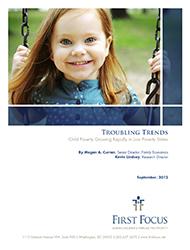 Recent years have seen a dramatic increase in child poverty, culminating in a twenty-year high of 22 percent in 2010. The 2011 data showed a national child poverty rate of 21.9 percent, essentially unchanged from the year before. Upon closer inspection, however, the very states that appear to be doing well are actually the states with the most concerning rates of growth in child poverty from 2010 to 2011. The top five states that emerge from this analysis – Hawaii, New Hampshire, Connecticut, Rhode Island, and Alaska – are states with historically low rates of child poverty (and with current rates well below the national rate), but saw their child poverty rates grow at least three times faster than the national rate in one year.
Recent years have seen a dramatic increase in child poverty, culminating in a twenty-year high of 22 percent in 2010. The 2011 data showed a national child poverty rate of 21.9 percent, essentially unchanged from the year before. Upon closer inspection, however, the very states that appear to be doing well are actually the states with the most concerning rates of growth in child poverty from 2010 to 2011. The top five states that emerge from this analysis – Hawaii, New Hampshire, Connecticut, Rhode Island, and Alaska – are states with historically low rates of child poverty (and with current rates well below the national rate), but saw their child poverty rates grow at least three times faster than the national rate in one year.
This paper offers a brief analysis of state trends in child poverty – tracking states that experienced the highest overall levels of child poverty in 2011, as well as states that saw the most rapid growth in poverty for their children. It also compares the states with the highest one-year growth poverty with a set of economic hardship indicators in an effort to understand the broader forces affecting children in these states. The paper concludes with a discussion of policy implications, connecting state child poverty and hardship trends and decisions made at the federal level.